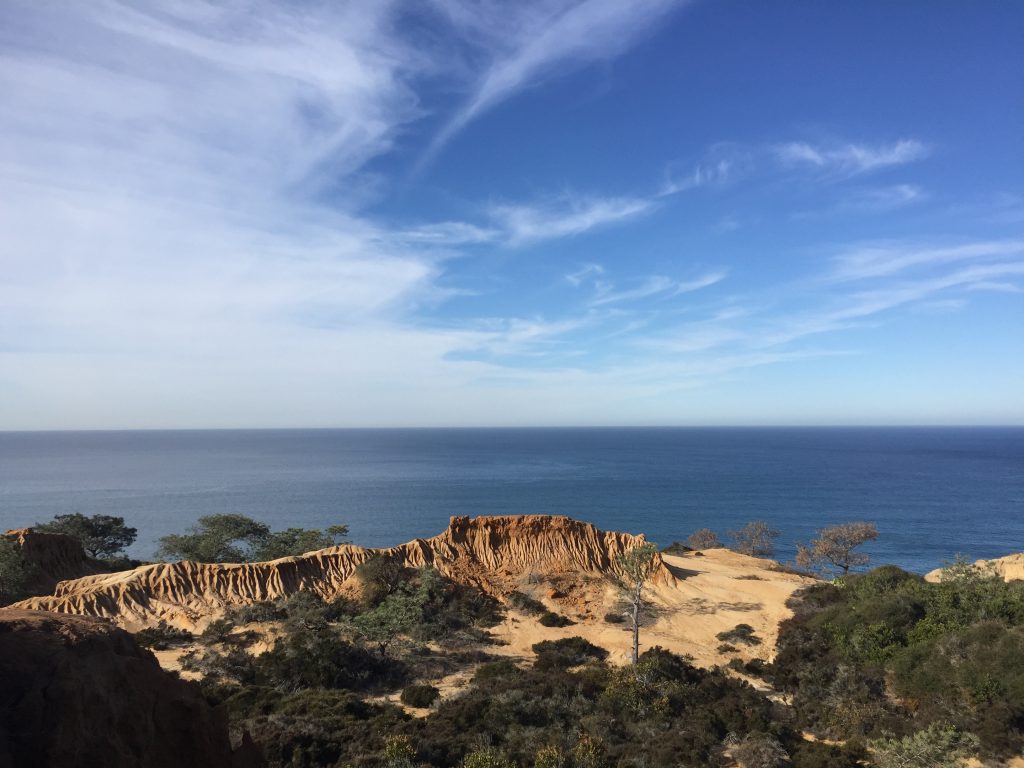Located on the northern edge of the City of San Diego Torrey Pines State Reserve is the home to one of the rarest trees in North America and a pocket of wildness that reveals California of a bygone era.
The location of the 2,000 acre reserve makes it both isolated and accessible at the same time. To the south is the famous Torrey Pines Golf course which provides a buffer from human developments. On the west is the Pacific Ocean. And to the north and east is the Los Peñasquitos lagoon and a series of steep hillsides and canyons. These natural barriers keep human encroachment at bay while allowing wild animals to come and go through a series of interconnected trails that run from the coast to several miles inland.
What to see and What to do
The first thing visitors will notice is the views. The old Highway 101 provides a 1.5 mile walking path the goes from beach level to the top of the coastal bluffs where the main visitor’s area of the reserve resides. At the top of the approximately 300 ft. bluffs there are sweeping views of the ocean and coastline from Point La Jolla in the South to Dana Point in the North. This path is very popular with local residents who walk, run and cycle up the hill for exercise. Depending on the time of year you can see whales on their yearly migrations as they swim up and down the coast. The top is where you will find many of the trail heads and the Ranger Station and Visitor’s Center.
Hiking
As mentioned there are about 8 miles of trails divided among six different routes inside the reserve. Most are relatively easy and provide great views of the different sections of the Reserve and also provide a path down to the beach. The trails will take you through the coastal chaparral and past clusters of the famous Torrey Pines and into an area called the Badlands where the earth and sandstone have been eroded creating beautiful patterns in the orange and tan earth. If you go early you may catch glimpses of some of the animals that live among the brush such as the California Quail.
*** There are several species of snakes in the area including rattle snakes. Keep an eye out for them, sometimes the like to warm up by laying in the middle of the trails.***
***2nd Danger Warning*** If you do take the Beach Trail be forewarned that approximately 1 mile south of “Flat Rock” is a part of Black’s beach which is a nude beach.
Torrey Pines
The name sake of the reserve the Torrey Pine is a rarest pine tree in North America and only found in two paces in the world. The first is the area immediately around the preserve and somewhat quixotically, the second is located 170 miles north west on Santa Rosa Island in the Channel Island chain. (we think an Osprey brought a pine cone from one of the trees out to the channel islands) One reason for the Torrey Pine’s rarely is their slow growth cycle. The pinecones themselves take 3 years to mature and the seeds and saplings are favorite food of the local animals. Once growing the trees can take several forms and look like different species due to their location. Torrey Pines that grow nearest the ocean exposed to the salt air and near constant winds off the ocean grow twisted and are sparsely foliated looking like giant gnarled bonsai trees. Others that grow in good soil with shade and water can be quite green and grow straight. The Torrey Pines on Santa Rosa Island can take the shape of large and bushy trees that extend out more than up.
Local Animals
On land Torrey Pines provides an oasis of sorts for many kinds of animals big and small. There are mountain lions, bobcats, deer and coyote. Most do a pretty good job of laying low in the day, but be on the lookout in the early mornings and around dusk and you may catch a glimpse of a bobcat or small herd of deer. On the smaller end of the scale there are horned toads, several species of lizards, snakes and (of course) squirrels.
Birds
In the sky and the trees you will see sea birds such as gulls, cormorants, egrets, herons, pelicans and Osprey.
Their are also peregrine falcons, several kinds of hawks, ravens. Smaller birds are gnatcatchers, scrub jays, bushtit, hummingbirds, lesser goldfinch and the aforementioned California quail. At night the owls come out and their eyes can be seen shining in the tree tops.
Noisy Birds
If you are an aviation buff you are in luck! MCAS Miramar is to the south east of the reserve and military planes and helicopters routinely fly overhead transiting along the southern boundary of the reserve going to and from Navy Ships and other points in the ocean. V-22 Osprey, CH-53E Super Stallions, AH-1W Super Cobras and F-18 Hornets are common. Occasionally you will see other “Aggressor” jets flying out to sea on their way to mix it up with the Hornet pilots.
Whether you are a local or visiting from out of town, Torrey Pines State Reserve offers a view of unspoiled California and is definitely worth a day or more of exploring. Its ideal location on the coast means you can walk on the beach, explore the trails and view the varied native fauna and unique flora. Combine all of this with amazing views and it puts Torrey Pines on par with any other attraction in the area.
